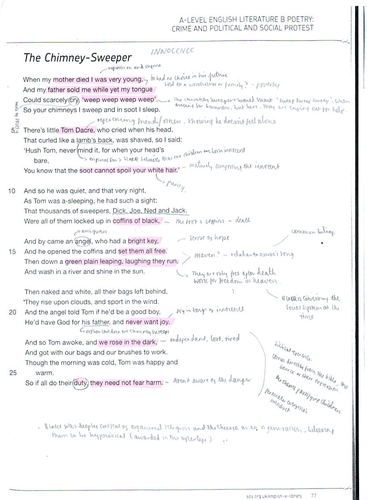The Chimney Sweeper Annotation
I weep The imperative for the reader to be appalled at the situation.
The chimney sweeper annotation. Work-related health problems included. A little black thing among the snow by William Blake is a dark poem that sought to expose the horrors of child labor. This need was often filled by child laborers.
The voice is that of the chimney sweeper boy but using words and expressions he would not use in real life. They are the among most vulnerable in society. 28th August 2020 Leave a comment.
An editable PowerPoint presentation on William Blakes The Chimney Sweeper. Download this annotation here. Genius Annotation 2 contributors The earlier version of The Chimney Sweeper from 1789s Songs of Innocence this poem would be mirrored by The Chimney Sweeper from Songs of.
The money is spent on churches while the children live in poverty forced to clean chimneys the soot from which blackens the church walls. The Chimney Sweeper a poem of six quatrains accompanied by William Blakes illustration appeared in Songs of Innocence in 1789 the year of the outbreak of. It is the companion to a poem of the same name that appears in the earlier Innocence collection and works as a kind of update on the plight of the chimney sweepera young boy forced to do the horrible work of cleaning chimneys.
In this stanza the chimney sweepers cry every blackening church appals provide an association which reveals the speakers attitude. As Blake makes clear such labor was akin to. The Chimney Sweeper is set against a backdrop of child labour prominent in England in the late 18th and 19th century.
Like many of Blakes most celebrated poems The Chimney Sweeper in both versions uses fairly straightforward language although some. The blackening of the church walls are. Deformed ankles twisted kneecaps twisted spines inflammatory eye syndrome and respiratory illnesses.
Weep in the notes of woe. The poem is made up of symbolism for example his mother and father are the State. There are two Chimney Sweeper poems by William Blake.
Sweep The portrayal of the misery of his position I weep. Work which was extremely dangerous with the potential to get stuck in the chimney or suffocate or burn to death. To Blake this makes a mockery of the love and care that should characterise the Christian religion.
One exception is The Chimney Sweeper a poem which introduces the suffering of the world and thus serves as a kind of prelude to Songs of Experience. The young chimney sweepers words show that he and his fellow sweep are in a harsh situation. In the first lines of The Chimney Sweeper the speaker describes a small black thing among the snow.
This is of course the child who has lost both his parents. The Chimney-sweepers are a symbol of poverty and exploitation of working-class children often orphans in the care of the church by the upper classes during the Georgian and Victorian periods in Britain. The toil and soot of the work become symbolic of the suffering all humans endure.
The first appeared in Songs of Innocence in 1789 while a second poem also called The Chimney Sweeper was included in Songs of Experience in 1794. The Chimney Sweeper As a Representative of Sorrow. The poem explores the plight of Victorian-era Londons child laborers many of whom were forced into work programs as infants.
In line with Blakes enduring engagement with biblical themes the young chimney sweepers. The expansion of factory production created an enormous need for labor. He says that his father had put him into the work as a chimney sweeper after the death of his mother.
They suffered many health problems because of their constant exposure to soot and because of the unnatural positions they were in so much of the time. As with the I version of The Chimney Sweeper Blake consciously employs the irony of weep as. The speaker also recounts the story of his fellow chimney sweeper Tom who was hurt when his head was shaved.
By Dr Oliver Tearle. The sweeps professional advertisement of his labour Sweep. The first industrial disease in history was suffered by young chimney sweeps.
The annotation prompts are a supportive tool intended to encourage further poetry analysis and interpretation. Boys as young as four were trained to climb chimneys and begin work. The chimney sweeps were not given any type of respiratory equipment or protective clothing.
Black symbolises doom and death while snow or winter symbolises solitude. The Chimney Sweeper is a poem by English visionary William Blake published in Songs of Innocence and Experience 1794. Children began to serve in numerous lines of low-wage work including chimney-sweeping.
Annotation prompts for William Blakes The Chimney Sweeper Songs of Innocence. Charles Dickens wrote often and accurately of the plight of Victorian-era Londons young chimney sweepers in works such as Oliver Twist. It is the companion to a poem of the same name that appears in the earlier Innocence collection and works as a kind of update on the plight of the chimney sweepera young boy forced to do the horrible work of cleaning chimneys.
As this poem is about the young chimney sweepers the speaker details how he gets involved in sweeping chimney business. The Chimney Sweeper.



